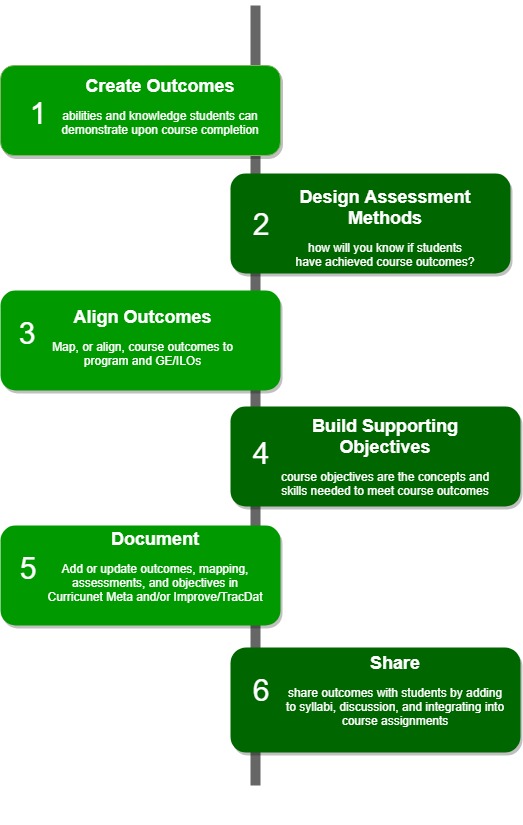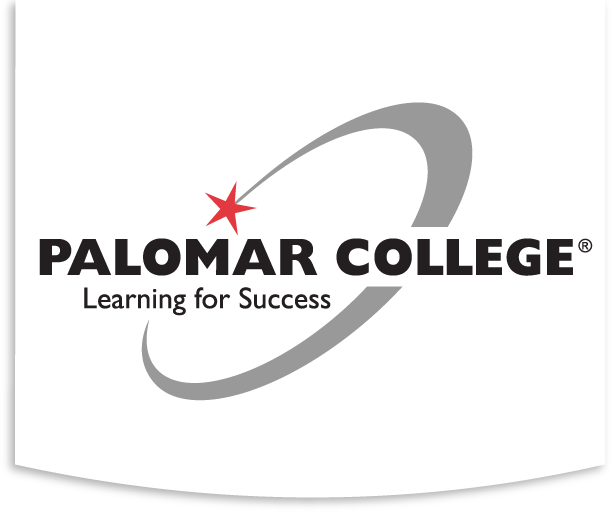Course and Program Outcomes
Goals
All active courses & programs practice ongoing assessment. Course and program outcomes must be assessed at least once every 3 years in order to align with the College's Instructional Program Review cycles.
The College's goals for assessment of course and program outcomes are:
-
- All courses and programs have at least 2 outcomes defined in Nuventive
- All active course and program outcomes have completed an assessment cycle (assess, reflect on results, improve) within the past 3 years.
- Where applicable, course and program outcomes are aligned to the Institutional Learning Outcomes. Consider using the Learning Outcomes Timeline to assess course and program outcomes aligned institutional outcomes.
- Course outcomes are aligned to program outcomes to ensure that student are meeting the program learning outcomes.
- Assessment cycles are documented in Nuventive and include the following:
-
-
-
-
- Outcome
- Assessment method
- Assessment results and reflection of results
- Plans for improvement
-
-
-
Active courses/programs include:
-
-
- Course and programs that have been offered in the last three years.
- Course and programs that are not scheduled for deactivation.
-
For assistance planning an assessment timeline for a discipline or program, contact the Faculty SLO coordinators.
Improving Learning Outcomes
Instructors regularly assess learning outcomes in order to make improvements to the curriculum and to help students succeed academically and professionally. When it comes time to assess program learning outcomes (PLOs) or course learning outcomes (CLOs) across multiple sections, however, the process becomes more challenging. This section presents an assessment model to guide faculty through the process of assessing PLOs and CLOs. The model was adapted from Walvoord and consists of the following four steps:
Assessment Steps
The first step to improvement as well as curriculum design is defining the outcomes that students should be able to meet upon completing a course or program of study. Outcomes are the measurable knowledge, skills and abilities that students are able to demonstrate subsequent to completing the course (as opposed to objectives which are discrete skills and concepts students should learn in order to meet the course outcomes). Each course should have at least two measurable student learning outcomes. When developing course and program outcomes, faculty should consider the skills and knowledge needed within a field of study, trade or career, or that help students think critically, engage civically and become lifelong learners.
The practical steps to developing, integrating, sharing and documenting outcomes at Palomar are presented below:
- Define outcomes – the abilities and knowledge students can demonstrate upon course or program completion.
Create at least 2 outcomes for each course and program. - Design assessment methods – how will you know if students have achieved the outcomes.
- Align outcomes – map, or align course outcomes to program outcomes, AND align course and program outcomes to college outcomes (i.e. general education/institutional outcomes).
- Build supporting objectives – objectives state the concepts or skills needed to meet the outcomes. Objectives are the means, not the ends. They are the building blocks designed to help students to achieve the course learning outcomes. Objectives may or may not be written as measurable terms.
- Document – add or update outcomes, assessments, mapping and objectives in Curricunet Meta and/or Nuventive Improve (TracDat).
- Share – share outcomes with students by adding to syllabi, through discussion, and integrating into course assignments.
Resources
Training Videos
- Program Outcomes - Introduction to program level outcomes and how they inform the program review process.
- Course Outcomes - Introduction to course outcomes and how they inform the program review process.
Defining Outcomes
- Writing Course Outcomes and Objectives for the COR
- Sample Course Outcomes and Objectives from Palomar CORs
- Writing Outcomes and Objectives, one page handout
- How do Outcomes Differ from Objectives
- How to Write Program Outcomes
- Bloom’s Taxonomy
- Designing Student Learning Outcomes (SLOs) to Improve Instruction, ASCCC
Aligning (Mapping) Outcomes
College Outcomes (General Education/Institutional Outcomes)
- Guide to Mapping courses and programs to college outcomes (GE/ILOs)
- Instructions for mapping course and program outcomes to college outcomes in TracDat/Nuventive Improve (page 16 and 18 of this guide – Mapping Course and Program SLOs to GE/ILOs)
Program Outcomes
- Aligning Course Objectives and Outcomes to Program Outcomes - Sample
- Instructions for mapping course outcomes to program outcomes in TracDat/Nuventive Improve
- Aligning course and program outcomes with Guided Pathways
Steps to Defining Outcomes

After outcomes and assessment methods have been defined, the next step is to gather information on student learning. There are so many ways to assess student learning that it can feel overwhelming. When assessing course and program outcomes, focus on gathering meaningful information and keeping it simple. Use the resources and models below to help with your next assessment. If you need assistance, contact your department SLO facilitator or an SLO coordinator. And remember to:
- Assess each course and program outcomes at least once every three years.
- Consider program review and college outcomes timelines when planning for assessments.
Assessment Models
- Program Assessment Model: Basic, No Frills Assessment Plan, by Barbara E. Walvoord Highly recommended read. This document presents a simple model for assessing program outcomes, which could also be applied to course outcomes assessment. Page 3 of the document summarizes the three steps of the model: 1. define outcomes, 2. assess outcomes using two assessment measures – one direct and one indirect assessment, and 3. hold an annual meeting to discuss assessment results and identify actions.
Assess with Canvas (single and multiple course sections)
- Use Canvas to Assess Outcomes The Learning Mastery Feature in Canvas allows instructors to assess outcomes in Canvas while simultaneously grading student work. Students are also able to view their progress in meeting outcomes. This feature can be used to assess both course and program outcomes. It is particularly useful for assessing outcomes for courses with multiple sections.
More Resources
After gathering information about student learning and analyzing the data, take any actions needed to improve student learning. Follow these simple guidelines:
- Decide on and complete one action item for each assessment.
- Take actions that are simple, effective, and doable and support student learning and improvement.
Resources
The final step in the assessment improvement model involves documenting outcomes activity.
-
Summarize outcomes, assessment, and actions in Nuventive Improve
- The following information should be recorded in Nuventive Improve for all course and program outcomes at least once every three years:
- Course/program outcomes and assessment plans
- Reflection of assessment results
- Actions/follow-up taken in response to assessment results
- Plans for future assessment
- The following information should be recorded in Nuventive Improve for all course and program outcomes at least once every three years:
-
Use findings for course/program improvement and program review.
- After documenting assessment activity in Nuventive Improve, we can refer to and use this data to identify student needs, update curricula, review programs, set goals and new initiatives, seek funding, etc.
Nuventive Improve Resources
- Nuventive Improve Login
- TracDat User Manual 2015-2016
- TracDat Easy Access Paths, 2015
- Guide to Running Recommended Reports
Nuventive Improve Support
Department SLO facilitators and the faculty learning outcomes coordinators are available to assist you in documenting activity in Nuventive Improve.
- For Nuventive Improve technical support email learningoutcomeshelp@palomar.edu
- Contact a department SLO facilitator

